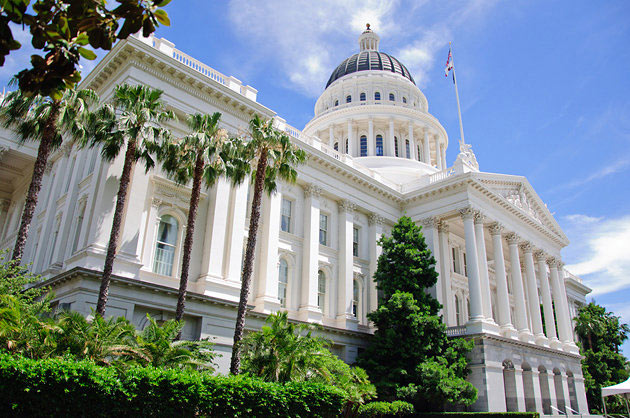Governor Brown signed seven climate bills in two weeks.
State Climate and Energy Legislation
Irene Moosen
Local Government Sustainable Energy Coalition (LGSEC)
Originally produced for the LGSEC newsletter

SEEC’s 2016 Climate and Energy Legislative Update fact sheet is now available – click here to view and/or download.
Governor Brown signed seven climate bills in two weeks. SB32 (Pavley) expands the previous emissions-reduction requirement to at least 40 percent below 1990 levels by 2030. The new 40 percent goal is considered a step along the way to the Governor’s ultimate goal of 80 percent reduction below 1990 levels by 2050 (Executive Order B-30-15).
In companion legislation, AB197 (Garcia) requires the California Air Resources Board (CARB) to refocus its regulations on “direct emissions reductions” that “protect the state’s most impacted and disadvantaged communities.” Large stationary sources and transportation sources of greenhouse gas emissions will be targeted for new CARB rules and regulations to reduce emissions. This new law makes CARB more responsive to the legislature by adding two lawmakers to CARB’s board as non-voting members, establishes a six-year term limit for voting members and creates a joint legislative committee to analyze and make recommendations on state climate programs, policies and investments. Extension of the cap and trade program to the new 2030 goal is not directly addressed in either bill, adding to the uncertainty surrounding the future of the recently underperforming auction.
AB1613, passed as a budget trailer bill, includes a spending plan for $900 million unallocated cap and trade auction revenue and reserves another $462 million for future years. CARB is directed to spend $363 million over the next year on its clean-vehicle rebate program, commercial-vehicle pilot projects and direct investments in heavy-duty trucks and off-road equipment. Another $135 million is allocated for the State Transportation Agency’s transit and intercity rail program and earmarks $80 million for urban-greening projects. Additional expenditures target methane emission reductions at dairy farms, improving forest health and weatherization and renewable-energy projects. Another $140 million is allocated for grants through the new Transformative Climate Communities Program created by AB2722.
AB1550 requires that a minimum of 25 percent of cap and trade auction revenues be spent on projects located within, and benefiting individuals living in, disadvantaged communities.” It requires at least another 10 percent for projects in low-income communities and communities near those designated as “disadvantaged.”
SB1414 requires that the recipient of an energy efficiency rebate or incentive must provide proof of permit closure and certify that the improvement or installation complies with the California Building Standards Code to the public utility providing the incentive or rebate.
In addition, the law requires the California Energy Commission (CEC) in consultation with the Contractors’ State License Board, local building officials and other stakeholders to approve a plan that promotes compliance with Part 6 of Title 24 in installation of central air-conditioning and heat pumps on or before January 1, 2019. The CEC is given discretionary authority to increase compliance with permitting and inspection requirements. Prior to approving the plan, the CEC must evaluate the best available technological and economic information to ensure that data collection and its use are feasible and achievable at a reasonable cost to government, industry and homeowners.
SB1383 (Lara), called the Super Pollutant Reduction Act requires CARB to approve and implement a plan to drastically reduce statewide emissions of high-impact but short lived climate pollutants such as methane and hydrofluorocarbon gases. The new law calls for a 50 percent reduction in black carbon emissions, a component of soot produced by diesel engines and a 40 percent reduction in methane and hydrofluorocarbon gases by 2030 from 2013 levels. These climate pollutants remain in the atmosphere for a much shorter period than carbon dioxide but have 80 to 3,200 times the global-warming potential of carbon dioxide over 20 years, according to the legislative analysis. This bill codifies many of the measures outlined in an April CARB draft strategy document targeting short-lived climate pollutant reduction.
Methane emission reductions are covered under AB32 and SB32 but the diary and livestock sectors currently are not regulated even though they account for more than half of California’s methane emissions. A goal of the new law is to encourage dairy farmers to collect manure in anaerobic digester tanks that produce biomethane as a renewable alternative to natural gas. The approved budget includes $50 million to support farmer investment in digester systems. CARB and the CPUC are required to establish infrastructure and procurement policies and incentives to support dairy biomethane projects and their integration with the state’s natural gas system. At least five pilot projects are to be pursued by the gas utilities to demonstrate interconnection to the existing pipeline system by January 1, 2018.
Local Government Commission Newsletters
Livable Places Update
CURRENTS Newsletter
CivicSpark™ Newsletter
LGC Newsletters
Keep up to date with LGC’s newsletters!
Livable Places Update – April
April’s article: Microtransit: Right-Sizing Transportation to Improve Community Mobility
Currents: Spring 2019
Currents provides readers with current information on energy issues affecting local governments in California.
CivicSpark Newsletter – March
This monthly CivicSpark newsletter features updates on CivicSpark projects and highlights.



